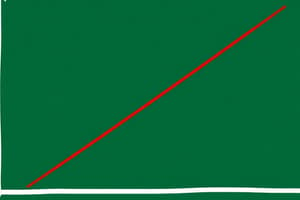Podcast
Questions and Answers
What aspect of consumer behavior do microeconomists analyze?
What aspect of consumer behavior do microeconomists analyze?
- Economic growth and inflation rates
- Marketing strategies and advertising techniques
- Global trade patterns and exchange rates
- Income, wealth, preferences, tastes, and substitution rates (correct)
Why is understanding production efficiency crucial for companies?
Why is understanding production efficiency crucial for companies?
- To increase consumer spending habits
- To expand globally and enter new markets
- To maximize profits by optimizing input and output levels (correct)
- To minimize taxes and tariffs
What role do governmental policies play in microeconomics?
What role do governmental policies play in microeconomics?
- Restricting access to global markets
- Influencing wages, subsidies, taxes, tariffs, and antitrust laws (correct)
- Encouraging monopolistic practices
- Directly controlling production levels of companies
How does a solid grasp of microeconomics benefit individuals navigating personal finance?
How does a solid grasp of microeconomics benefit individuals navigating personal finance?
What do microeconomists aim to determine through cost analysis?
What do microeconomists aim to determine through cost analysis?
How do businesses stay ahead in today's competitive environment according to the text?
How do businesses stay ahead in today's competitive environment according to the text?
What is the main focus of microeconomics?
What is the main focus of microeconomics?
How do supply and demand curves interact in microeconomics?
How do supply and demand curves interact in microeconomics?
What happens when there is an increase in demand but no flexibility from suppliers?
What happens when there is an increase in demand but no flexibility from suppliers?
Which market structure involves many firms selling similar but not identical products?
Which market structure involves many firms selling similar but not identical products?
In microeconomics, what framework is used to understand how producers compete and influence market outcomes?
In microeconomics, what framework is used to understand how producers compete and influence market outcomes?
What does a shift in either supply or demand curve lead to in microeconomics?
What does a shift in either supply or demand curve lead to in microeconomics?
Flashcards are hidden until you start studying
Study Notes
Exploring Economics through Microeconomic Lenses
Microeconomics is one of two major branches within the vast field of economics, dealing with individual decision-making processes, analyzing behavior in smaller markets, firms, and households. This scientific discipline helps us understand how different economic agents interact within their environments to create outcomes such as supply, demand, pricing strategies, consumer choices, and resource allocation—the backbone of our daily lives and global economies. Here's a closer look at several fundamental concepts in microeconomics.
Demand Curves and Supply Curves
At the core of microeconomics lies the concept of supply and demand curves, which illustrate the relationship between price and quantity demanded/supplied by buyers and sellers, respectively. A shift in either curve can alter equilibrium prices and quantities traded, leading to changes in markets. For example, an increase in demand might cause an upward movement along the demand curve, resulting in higher market prices for goods if there isn’t enough flexibility from suppliers on the supply side to compensate.
Market Structures
Market structures—such as perfect competition, monopolistic competition, oligopoly, and monopoly—are key frameworks used to understand how producers compete and influence market outcomes. While these terms may sound abstract, understanding them empowers you to decipher why some companies offer low prices while others remain unchallenged in specific industries.
Consumer Behavior
In microeconomics, we delve into consumer psychology, examining how factors like income, wealth, preferences, tastes, and substitution rates shape individuals' spending habits. By anticipating shifts in people's priorities and needs, businesses make well-informed decisions and stay ahead in today's fiercely competitive environment.
Production Efficiency
For companies aiming to maximize profits, production efficiency becomes paramount. In cost analysis, microeconomists investigate various costs, including fixed costs, variable costs, and marginal costs, to determine optimal output levels where profitability peaks. Understanding these fundamentals allows corporations to optimize inputs and outputs effectively without overspending or leaving money on the table.
Government Intervention
Governmental policies also play a significant role in shaping markets under the microscope of microeconomics. Policies influencing wages, subsidies, taxes, tariffs, minimum wage regulations, antitrust laws, and more all impact how markets function and evolve over time. Whether it's addressing unemployment concerns or safeguarding consumers against exploitation, government intervention is a crucial component of the modern economy.
Understanding microeconomics unlocks profound insights into real-world phenomena and enables you to view situations through new lenses when navigating personal finance and broader business dynamics. It's about simplifying complex interactions down to their most basic elements and paving ways towards wiser, data-driven decision making. So, whether you're managing your household budget or spearheading multimillion dollar projects, a solid grasp of microeconomics will undoubtedly serve you well!
Studying That Suits You
Use AI to generate personalized quizzes and flashcards to suit your learning preferences.




